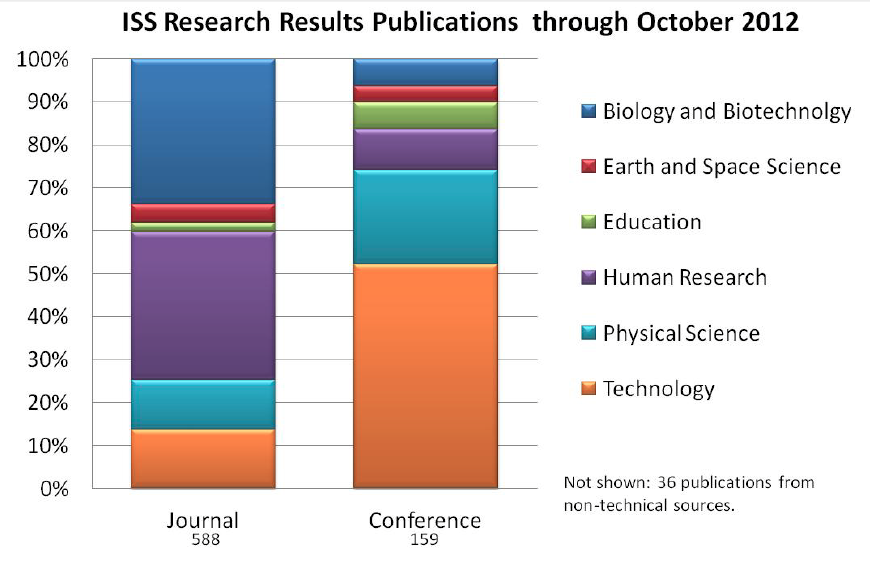I like to bore anyone who’ll listen with the fact that human space flight, and the International Space Station in particular, are lousy ways to do scientific research, so in fairness I thought I’d point out that NASA has put out a document providing information on the science performed on the ISS.
Much of the information is hard to interpret. For instance, there are graphs quantifying the number of “investigations” performed as a function of time, but it’s hard to know what to make of this, because I don’t know what counts as an investigation.
Here are the research highlights listed:
- Virulence of Salmonella microbes increases in space; researchers have used this discovery to create an approach to develop new candidate vaccines.
- Nutrition studies conducted on the space station show that diets rich in Omega-3 fatty acids are correlated with reduced bone loss.
- Candidate treatments for a form of muscular dystrophy and for testicular cancer have been developed based on space station research results.
- Space station research has involved over 1.2 million students in the U.S., and 40 million more have participated in educational demonstrations performed by astronauts onboard ISS.
- Capillary flow experiments on the space station have produced universal equations for modeling the behaviors of fluids in space.
- The space station serves as a platform to monitor climate change, disaster areas and urban growth on Earth.
- Recent plant studies conducted on the ISS indicate that some of the root growth strategies that had always been thought to require gravity also occur on orbit. This finding provides fundamental insight into the processes of plant growth and development on earth, as well as contributing to our understanding of how best to grow food in space and other novel environments.
I could make snide remarks about some of these, but I won’t. You can decide for yourself how impressed to be. Bear in mind that the cost of the ISS is estimated at $100 billion.
Here is perhaps the most useful quantitative data: scientific publications resulting from ISS research:
If you assumed that the primary purpose of the ISS was to do science, then each journal publication coat about $170 million ($100 billion divided by 588). Even if you assumed that the ISS is 1% about science, it’s $1.7 million per publication, which is an insanely large amount compared to “normal” scientific spending.
The moral of the story: the ISS, and human space flight in general, are not about science. Any science done on them is a side show. I think it’s worth repeating this regularly, because in many peoples minds Space = Science. In particular, I worry that, when people think about the federal budget, more money spent on things like the ISS will mean less money for science.

Very interesting reference to the number of publications coming out of the ISS. I’m also tempted to make snide comments about at least a couple of the scientific purposes. 🙂
The US spends about 2 million dollars on defense—per minute. Nice to put some things in perspective.
In general, of course, I agree; space is a very inefficient way to do science, especially (wo)manned space flight. That doesn’t mean that it isn’t worth doing, though; as long as the nation spends less than, say, its women do on makeup, I think it’s OK—but not for the advancement of science.
I agree. Human space flight has value due to its intrinsic awesomeness, and I don’t object to public funding of it. I just want people to think of it as a different category from science, because I fear that funding for one cannibalizes the other.
And by the way I’d love to see the US defense budget reduced by a large factor.